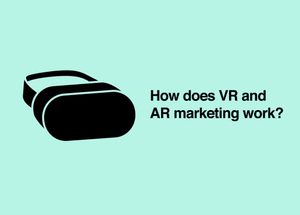How does virtual reality and augmented reality marketing work?
Over the last few decades, immersive technology has had blinking spotlight. Some years it's the hot topic, only for it to lose its shine and then buzz again a few years later. This was the case in 2013 with Google glass, 2016 with Oculus Rift and Hololens, and in 2021 with the Metaverse.
While immersive technology can ignite our imagination of visiting new places and shared experiences, immersive tech has had ongoing challenges. Challenges with everything from its hardware to user interface, user experience, application development and affordability. Yet irrespective of these challenges there remains a large community of passionate professionals and enthusiasts that continue to drive the technology forward.
From a marketing perspective, immersive technology shouldn't be treated as another marketing channel - rather it's a device for users to satisfy their needs in a different format. As the applications on immersive devices grow there will be marketing opportunities and it's these opportunities that marketers need to watch.
Types
- Virtual Reality (VR) – Virtual Reality is a computer generated environment making the user feel they are immersed in their surroundings. Because VR is immersive it has great potential for sharing specialised experiences such as scuba diving, being part of final football game, visiting fantasy worlds and more.
- Fully immersive VR – Fully immersive simulations give the users the most realistic experience possible including sight, sound and touch.
- Semi-immersive VR – Provides partially virtual environment to interact with.
- Non-immersive VR – A virtual reality that does not have immersion, such as a typical video game experience.
- Augmented Reality (AR) – Augmented Reality is an interactive experience of a real-world environment, such as seeing layered visuals on top of a real object. Because AR can provide layered information on top of a real-world experience, it has great potential for training simulations and enhancing daily activities.
What sort of marketing is possible with immersive technology?
There are several ways of developing marketing using immersive technology.
VR/AR placements
Placements inside VR and AR applications can include everything from avatar skins/clothes, unique items, real-estate, and more.
The advantages of creating such placements allow users to engage with your brand in a natural way.
We recommend finding an existing application where your brand is suitable and partner with the application development team to include digital assets that enhance the experience. This could be including a make-up product in a cosmetic VR experience, or a car product within a racing game, and so on.
Digital advertising such as banners or campaign assets aren't recommended for immersive experiences as it can be disruptive and feel forced.
Mobile devices and immersive filters
Immersive experiences are not restricted to headsets, with many brands taking advantage of filters using mobile and desktop cameras.
Filters can enhance the shopping experience, particularly within the fashion, cosmetic, health and fitness industries. Bailey Nelson have a virtual feature on their product pages that allow shoppers to try on their glasses.
New application development
Brands can create a completely new application using specialists and VR or AR development tools, however this approach is on the heavier production side and is not a small undertaking. Developing a bespoke VR or AR application is similar if not more extensive than creating a new mobile app, so the business case needs to stack up before exploring this level of development.
eSports sponsorships
There is a growing VR gaming community which also compete in competitive tournaments such as the VR Master League.
Sponsorship of these communities is a good way of getting exposure to the VR community without the need to build digital assets or applications.
Pros 👍
Note: Some of these points are more specific to VR, AR or eSports.
- Product demos and showcases - Immersive technology is great at showing products and features outside the retail environment. This has already been embraced by many fashion outlets and even the inside of car engines such as Porsche.
- Training - Both VR and AR enable superior training experiences if done well, this could be advantageous for training specialists that operate under high pressure conditions or work with complexity. Training simulations could be useful for emergency services, pilots, military, police, surgeons and so on.
- 3D design - Allowing for 3D spaces can improve the design process, whether this is designing the interiors of buildings, engines or shaping motorcycles.
- Youth strategy and supporting eSports - There are already many large companies reaping the benefits of eSports sponsorship and its effective youth strategy including Logitech, RedBull and Samsung.
- High engagement - Immersive advertising performs very well, partly due to the nature of the immersive experience and focus required of the users.
- Early VR/AR marketing - Brands that take a risk and try new technology early can sometimes be advantageous. Pokemon Go's immersive app has had over 750 million downloads and is example of the success that VR experiences can bring to brands.
Cons 👎
- Competitive and moving landscape - Google, Microsoft, Apple, Meta as well as independent companies are all competing in the VR and AR space. This makes it difficult to understand which technology to use, which brands to partner with and the developers required.
- Difficult customer adoption - Unlike many marketing channels, both VR and AR aren't accessible by the majority of audiences. It requires time for a user to purchase a headset, set up the device and decide to engage.
- Motion sickness - Many users simply can't use VR because of the motion sickness, which is a significant barrier of entry until the technology solves this issue.
- Gamer backlash - Ad placements within games can create significant backlash from gamer fan-bases and the gaming community. It's important to understand the relationship between marketing and games, and ensure that the gaming experience is enhanced not disrupted. To avoid this work closely with the game developers and optimise based on user feedback.
- Expensive - Right now to get virtual or augmented digital assets built requires specialised developers. Getting into VR and AR requires a lot of consideration of the ROI from tapping into these audiences.
AR Headsets
- Nreal Air
- Nreal Nebula
- Nreal Light
- Rokid Air
- Microsoft Hololens 2
- Vuzix Blade Upgraded
- Google Glass Enterprise 2
VR Headsets
- HP Reverb G2
- Valve Index
- Sony Playstation PSVR 2
- Lenovo ThinkReality A3
- Meta Quest Pro
- Meta Quest 2
- HTC Vive Cosmos
- HTC Vive Pro 2
It's also rumoured that Apple will be announcing a VR/AR headset in 2023.
Platforms and developer tools
Immersion tools and platforms come in different categories. Some tools are more specific to AR or VR, or are specific to certain industries such as architecture or gaming.
Collaboration platforms
Content Management Systems
Development Software
AR Development Software
Game engines and 3D development
Martech Playbooks verdict
You always need a clear marketing strategy before committing to technology. The question that marketers should ask themselves before exploring new channels is 'Who are we trying to communicate with?'. In the case of both VR and AR, it's predominantly the eSports community at this point. If that's a segment opportunity for your marketing team then definitely explore it.
There are training simulations and product demos that can be enhanced with the use of AR and VR, for those applications it's important to work closely with the product team to determine what problem you are solving with immersive reality assets.
Expect the hype around immersive technology to continue rising and falling, and when you see your audience engaging with the technology that is the time to start exploring this opportunity.


